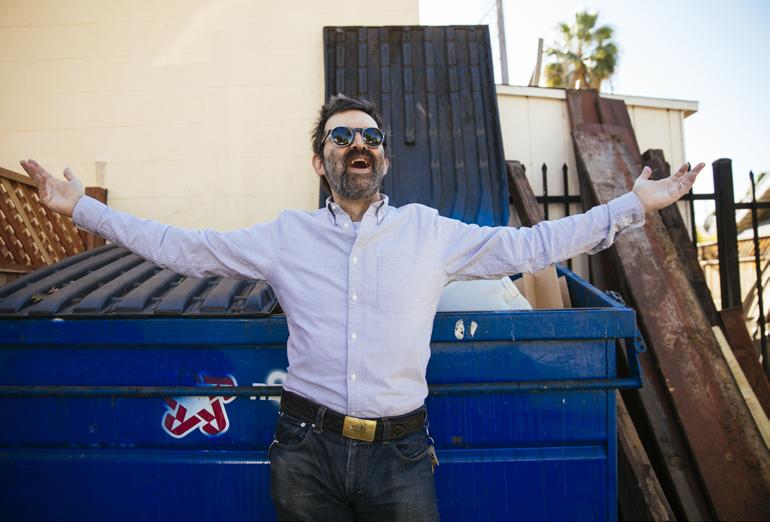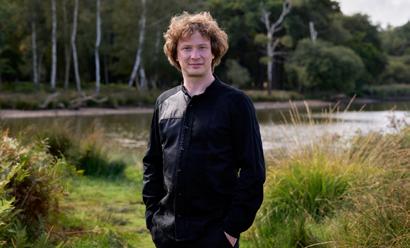
6 minute read
LIGHT AT THE END OF THE TUNNEL
MARK OLIVER EVERETT’S SURVIVAL STORY: EELS
Listening to the records of the American band Eels, we might justifiably ask what accounts for the sadness permeating their songs. The answer is found in the tragedy-filled life of singer-songwriter Mark Oliver Everett, known under the stage name E, in which music became a means of survival and processing events. Of the famous people in popular music, perhaps only Roy Orbison suffered more blows, and so it is some small miracle that there also remains plenty of room for joie de vivre in E’s work. By
Advertisement
István Nagy
Mark Oliver Everett was born in 1963 in Virginia. His father, Hugh Everett III, was a renowned quantum theorist – who, at the age of twelve, corresponded with Albert Einstein about the secrets of the universe –, while his mother was a writer and poet. The young Mark showed little affinity for physics, instead burrowing himself in his older sister’s record collection. His parents bought him a drum kit at a garage sale as a gift, and later he also took up guitar and piano. His adolescent years were turbulent, as he was expelled from school and got into trouble with the law: he then put all his energy into music, which he could also credit for a permanent physical injury, after leaving a concert by
The Who with damage done to his eye by a laser. Not long afterwards, at the age of just nineteen, he endured his life’s first major tragedy when he found his father dead from a heart attack.
NAVIGATING SLOWLY BUT SURELY
Everett self-released his first cassette in 1985 under the title Bad Dude in Love, but it made no waves. His album A Man Called E was released by a major label, Polydor, in 1992; however, only the song Hello Cruel World achieved any notable success. Even a slot supporting Tori Amos on tour came in vain, as one year later, in the wake of an indifferent reception of his second album Broken Toy Shop, Everett’s label let him go. However, his luck did not disappoint him as he formed Eels with musical partners Butch Norton and Tommy Walter, and Steven Spielberg and David Geffen’s then nascent DreamWorks Records immediately offered the band a deal.
To this day, Eels functions as a project band for Everett: although his fellow musicians sometimes share the songwriting, their primary role is on stage. Not only does Eels not fit the functional parameters of a rock group, but its style, which incorporates electronic music as well, is hard to categorise. Perhaps the terms art rock, indie or alternative rock are closest to the mark. The 1996 debut album Beautiful Freak already showcased a mature sound, and to prove just how right the label had been in signing the band, the album made the uk Top 5, while the singles Novocaine for the Soul and Susan’s House also climbed high up the charts.
Through Tragedy To Fetal Position
After the album’s release, Everett’s sister Elizabeth committed suicide, a new tragedy that essentially defined the mood of the second Eels album ElectroShock Blues, released in 1998. The anticipated loss of another family member made its mark on creative work in the studio, as an incurable illness inevitably claimed the life of E’s mother not long after the record’s release. Two years later, Daisies of the Galaxy became a record with a considerably more positive tone, as did 2001’s rockier Souljacker, recorded with John Parish. However, the album was released just a week after the September 11 terror attacks, souring Everett’s life with yet another family tragedy as his cousin Jennifer was a flight attendant on the plane that crashed into the Pentagon.
After this, Everett changed direction for a short time, releasing a dance record entitled I Am the Messiah under the pseudonym MC Honky, and writing the score for the film Levity. Recorded in only ten days, the 2003 Eels album Shootenanny! proved less successful than its predecessors; however, two years later, its successor, the thirty-three-track, ninetyminute long Blinking Lights and Other Revelations, became his magnum opus. E’s masterpiece was meant as a love letter to life itself, of which there can be no doubt on hearing its rousing songs, such as the single Hey Man (Now You’re Really Living), while the guest appearance of Tom Waits on Going Fetal really serves as the icing on the cake.
emerged from jam sessions in 2013, while one year later The Cautionary Tales of Mark Oliver Everett returned the band to the Top 10 of the uk album charts after a long absence.
Despite this success, Everett considered retiring, but the birth of his child provided him with fresh inspiration to return to writing songs. The 2018 album The Deconstruction was, accordingly, more optimistic in tone, even if the 2020 release Earth to Dora once again entered darker waters. E nevertheless shows no signs of stopping, with the release of Eels’ 14th studio album last year under the title Extreme Witchcraft, once again boasting the work of producer John Parish after a break of two decades. Since this is the band’s first visit to Hungary, we can aptly hope for a ‘best of’ set to accompany the songs from the latest album. Just as happy moments shine through the gloom in Mark Oliver Everett’s work, his life is proof that there’s always light at the end of the tunnel.
New Inspiration
A four-year hiatus in his discography then followed, during which Everett published his autobiography and took part in a documentary about his father’s work. He returned at the front of Eels with a trilogy of albums released in 2009 and 2010 (Hombre Lobo, End Times, Tomorrow Morning), on which a melancholic mood dominated the songs once again. Eels remained active in the 2010s: Wonderful, Glorious
7 APRIL | 10AM
Hungarian National Gallery
GULÁCSY THE ART OF LAJOS GULÁCSY (1882–1932)
ONE EYE ON DREAMS, THE OTHER ON REALITY
‘Oh miraculous / Saintly, pure artist, Giotto’s good successor’ – Gyula Juhász recalled of the painter Lajos Gulácsy in his famous poem. Essentially an autodidact, this profoundly sensitive artist was allotted barely fifty short years of earthly existence, the last decades which he largely spent in mental institutions. Gulácsy created a fantasy dream world on his canvases: surrealistic paintings heavily influenced by the Pre-Raphaelites which aspire to guide the bewildered generations of posterity to the imaginary Na’Conxypán.
Gulácsy found his main sources of inspiration in the Middle Ages and the Rococo. His images can be better grasped as moods or presentiments, where intuition is an important tool in their reception. We need only to look at the reactions of contemporary critics, who attempted to describe his art using musical and poetic images. A refined enervation, glowing decadence, restrained sensuality and mystical symbolism permeate his canvases. This temporary exhibition of the Hungarian National Gallery, presenting almost two hundred works, fulfils an ambitious goal in initiating a rewriting of the Gulácsy narrative. In addition to well-known masterpieces, the exhibition showcases photographs, drawings, sketches and contemporary reactions, as if confirming the master’s own words, ‘I experience the world only half dreaming. With one eye I gaze into the lying, sweet illusory images of dreams, while my other eye is always observing reality.’
The exhibition is on view between 7 April and 27 August.
16 APRIL | 7.30PM
Müpa Budapest – Béla Bartók National Concert Hall
KRISTÓF BARÁTI, SANTTU-MATIAS ROUVALI AND THE PHILHARMONIA ORCHESTRA

Common Denominators
Active for almost eight decades, London’s Philharmonia Orchestra has a long history of continuous renewal – of its many audience-friendly activities, we should highlight the collection of music samples available free of charge on its website –, and in autumn 2022 it opened its second season under the leadership of the outstanding Finnish conductor Santtu-Matias Rouvali. The current chief conductor of the Gothenburg Symphony Orchestra, and soon outgoing chief conductor of the Tampere Philharmonic Orchestra, Rouvali replaced his compatriot Esa-Pekka Salonen in the principal conductor’s post at the British orchestra. Soloist for the evening is violinist Kristóf Baráti, no accidental winner of the Bartók–Pásztory Prize, which we will have the chance to confirm at this concert with one of the three works on the programme being Béla Bartók’s Violin Concerto No. 1, a work of decadent secessionism that was never performed in the composer’s lifetime. Written in 1907–1908, the concerto remains as one of the proofs of the anecdotal story of Bartók’s unrequited love for the violinist Stefi Geyer – a secret which was preserved in Geyer’s drawer until she revealed it shortly before her death in 1956. In the piece, the Stefi Geyer motif (D–F#–A–C#), which can be observed in several of Bartók’s subsequent works (even in Divertimento dated 1939), could be heard for the first time. Despite their separation in time by almost a century, parallels between Beethoven and Sibelius are constantly explored, and perhaps not by accident as – for example, in the case of Beethoven’s Leonore Overture No. 3 and Symphony No. 5 by Sibelius – the common denominator lies in the years of struggle and painstaking work of both composers. Both works required multiple revisions before emerging as the masterpieces that, even today, can elicit the same rapturous response as they did among contemporary audiences.
7 APRIL | 7.30PM
Pesti Vigadó – Ceremonial Hall
GYÖRGY VASHEGYI WITH THE ORFEO ORCHESTRA AND THE PURCELL CHOIR








